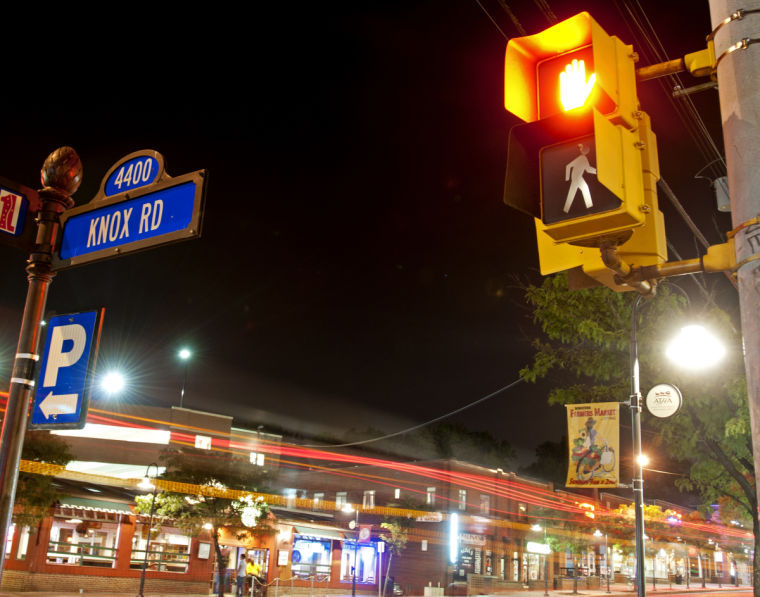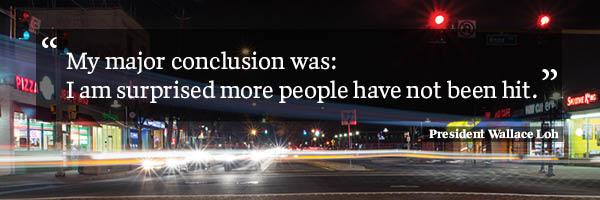
Route 1 and Knox Road
Swarms of students migrate to Route 1 each weekend looking to get into their preferred bars for a night out with friends. They wait in lines that curve around the block or spill into the street.
This same section of road sees traffic of about 30,000 cars each day, according to the Annual Average Daily Traffic report from the State Highway Administration. And in the last 11 months, five pedestrians have been struck — two fatally — at the intersection of Route 1 and Knox Road.
“When people say this is the second-most dangerous stretch of highway in the entire state, it really hit home,” said university President Wallace Loh. “I will emphasize one doesn’t really know how dangerous it is until you go there on the weekend night at 1 a.m.”
Saturday night, Loh, with University Police Chief David Mitchell, walked around this section of Route 1 from about 11 p.m. until 2 a.m. Sunday. Loh said this helped him see that area’s safety issues in a new light.
To address these concerns, the College Park City Council sent a letter to the SHA on April 15 requesting safety improvements, and Loh and College Park Mayor Andy Fellows sent a similar letter to the agency April 23. Mitchell said he has talked to SHA about this topic but has not been pleased with the lack of action on their part.
“We’re all united on this, what needs to be done,” Mitchell said. “And we’ve spoken loudly with one voice, and the lack of response has been deafening. More than just words, we need action, and we need it now.”
Some of the safety suggestions from the Student Government Association and university and city officials include lowering the speed limit from 30 mph to 25 mph, instituting a four-way red flashing light during weekend nights, using automatic walk signals, extending the speed cameras’ hours of operation and putting a traffic light at the intersection of Hartwick Road and Route 1.
“Even though we want to be making all of these decisions right now and we want to see instant progress, everything has to go through SHA, and for the most part they’ve been not unresponsive, but they seem almost indifferent to what we’ve been asking for,” said SGA Vice President of Student Affairs Catherine McGrath. “They really don’t see the urgency of it.”
But SHA media relations manager David Buck said pedestrian safety is a top concern, and officials from SHA will meet with the Maryland Department of Transportation, university officials, including Loh, and local officials, including, Sen. Jim Rosapepe (D-Anne Arundel and Prince George’s), Fellows and Prince George’s County Councilman Eric Olson today to discuss this issue further.
“It couldn’t be any higher of a priority,” Buck said. “We’re moving extremely quickly with the college, completely understanding that there’s only about a month left of school. We almost immediately got this meeting with the president … it must be a collaboration and everyone needs to be on board for this to work.”
Mitchell said he met with university officials, Prince George’s County officials, city officials, city engineers and SHA engineers May 2, hours before the third pedestrian this month was hit.
At the meeting, Mitchell said, he asked SHA to put a temporary barrier in the median. SHA said they would get back to him by Monday, Mitchell said, but he has yet to receive a response.
“I hope I’ll see a greater sense of urgency than I’ve seen so far,” Mitchell said. “It’s very disappointing that what could be a priority seems to not be a priority.”
But SHA Bicycle and Pedestrian Coordinator Dustin Kuzan said the agency is working to find the most effective and efficient measures to improve pedestrian safety. The agency is unsure if barriers in the median are the answer.
“There’s not a whole lot of science behind pedestrian safety,” Kuzan said. “If you put in a median barrier … there is not much research out there on how effective they would be.”
About 2,700 people have signed a petition since April 17, asking the city to build sidewalk barriers outside of Cornerstone and R.J. Bentley’s. Loh said he would be in favor of this as a temporary solution.
“The other thing that just stunned me is how narrow sidewalks are,” Loh said. “There are actually people standing not on the sidewalk but on the road, and cars are zipping by. My major conclusion was: I am surprised more people have not been hit.”
R.J. Bentley’s combats this issue with a security rope keeping the line close to the side of the building.
“We’re always concerned with student safety, and we would like to figure out how we can stop the problem,” said R.J. Bentley’s general manager Pat Ahern.
Buck said pedestrians at the bars on Route 1 are usually intoxicated by the time they are walking, and jaywalking, home. He said this safety issue would remain regardless of engineering improvements.
“We have a very small piece of this from a highway perspective, [but] an important one as people come across Route 1,” Buck said. “But if pedestrians are going to continue going across the street on Route 1, drink until 2:30 in the morning and then walk back across the road in the middle of the block drunk, again that has to change. The theme here has to change.”
Mitchell said changing pedestrian behavior will take time. He is instead focusing on immediate changes such as increasing police presence. Prince George’s County Police and university police have been working overtime, monitoring this dangerous stretch of highway, Mitchell said.
“Let’s face it: Many of the pedestrians have been consuming alcoholic beverages, and that’s fine,” Mitchell said. “You’re going to find that in every major city and every state in the country. We need to recognize that people come out, they enjoy dinner, they may have a few drinks and they expect to be safe.”
Although McGrath recognized the reckless behavior of some pedestrians, she said SHA should prioritize making engineering changes to this section of Route 1.
“There have been so many pedestrian incidents and fatalities just this semester that this is really something that is unusual,” McGrath said. “There is clearly a significant problem that is not only the way pedestrians are crossing, but clearly something with the highway itself.”
Senior staff writer Talia Richman contributed to this report.




